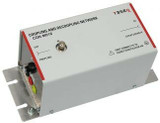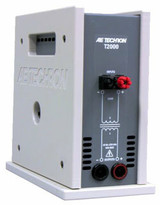Coupling Decoupling Networks (CDNs) Categories
Coupling Decoupling Networks (CDNs) Test Equipment
-
CDN M2/M3-16 Coupling Decoupling Network
SKU: 8696
Frequency Range: 150 kHz - 230 MHzMax RF Test Voltage: 30 VRF Input Power: 6 W (continuous)RF Input Connector: 50 Ω BNC femaleInput Voltage EuT (AE): 250 VAC, 400 VDC$390.00 - $3,900.00In Stock -
3cTest SEPN 38100T Surge/EFT 3 Phase Coupling Network
SKU: 7271
EUT Load Capacity (AC): 380V, 100 A, 50 Hz/60 Hz three-phase-five-wireEUT Load Capacity (DC): 450 V, 100 AFuse: 6 AMax Power Consumption: 200 WDimensions: 600 x 800 x 1830 mm (W x D x H) 23.6 x 31.5 x 72 inIn Stock -
Teseq CDN ST08 Coupling Decoupling Network
SKU: 8413
Frequency Range: 10 kHz to 80 MHzApplication: CDN for screened eight lines with RJ45 connectorCurrent Rating: 1000 mAEUT Connector: BNC 50 ΩCommon mode impedance (EUT Port) 10 kHz to 26 MHz: 150 Ω ±20 Ω$1,600.00Typically in Stock -
AE Techron CR 600 Chattering Relay for DO-160 Section 19
SKU: sku-CR600
Coil Voltage: 24 V DCCoil Current: 84 mAContact Rating: 30 ATypical Pulse Voltage: > 700 VppTypically In Stock -
3ctest CDN 405AF4 Surge Coupler for Unshielded Unsymmetric Lines
SKU: 3CT-CDN405AF4
Test Standards: EN/IEC 61000-4-5Applications: Data lines Unshielded, Unsymmetrical Surge ImmunityData Rate: 100 Kbit/sSurge Voltage Handling: 6kV (10kV Available)Typically In Stock -
AE Techron T1000 Magnetic Field Susceptibility Transformer
SKU: 8537
Frequency Response: 400 Hz - 30 kHzCurrent Handling: 100 Amps RMS up to 1 kHz derated to 10 Amps at 30 kHzTurns Ratio: 10 to 1Max Output Voltage: 200Vp Primary (20Vp Secondary)Dielectric Test: 1,200 VDC$175.00 - $339.00Typically In Stock -
3ctest TPT-7637-4C100 Coupling Transformer ISO 7637-4 Pulse B
SKU: 8736
Frequency Range: 1 kHz – 300 kHzMax Unsaturated Voltage: 100 @ f ≥ 1 kHzMax Current: 32EUT Max Current: 100In Stock -
CDN-M3-32A-HV AC + DC 1000V RF Coupling/Decoupling Network
SKU: 12165
Application/Test Type: unscreened supply lines (mains) AC + DC, RF Conducted DisturbancesCurrent Rating: up to 32 AmpsMax Voltage: up to 1,000 VoltsFrequency Range: 150 kHz to 230 MHzMains & EUT Connections: banana socketsInquire for Availability -
Teseq CDN M532 5-Line/32 Amp RF Coupling/Decoupling Network
SKU: 12093
Associated Equipment: RF Conducted Immunity Test SystemsCommon Mode Impedance: 150 kHz to 26 MHz: 150 Ω ±20 Ω; 26 MHz to 230 MHz: 150 Ω +60 Ω / -45 ΩCurrent Rating: 32 Amps MaximumDecoupling of Common Mode Disturbance: Greater than 30 dBDimensions: 6.3 x 6.3 x 20 inches (16.0 cm x 16.0 cm x 50.0 cm) -
Schwarzbeck CDN S19 HDMI Coupling Decoupling Network
SKU: 8418
Frequency Range: 150 kHz - 230 MHzMax. RF Test Voltage: 30 VMax. RF Input Power: 6 W (continuous)RF Input Connector: 50 Ω BNC femaleEuT, AE Connectors: HDMI female$230.00 - $2,295.00In Stock -
Schloder CDN M4-32_10 10 kHz – 230 MHz Coupling Network
SKU: 11766
Associated Equipment: RF Conducted Immunity Test SystemsEMC Standard: IEC/EN 61000-4-6 -
3ctest CDN ST8 Coupling/Decoupling Network For Shielded Symmetric Line
SKU: sku-1702
Frequency Range: 150 KHz - 230 MHzMax. AC voltage (line to ground): 100 VMax. DC voltage (line to ground): 150 VRF Input Port: <20V (BNC)Standard Met: IEC 61000-4-6$1,195.00Lead time 10-12 weeks


















